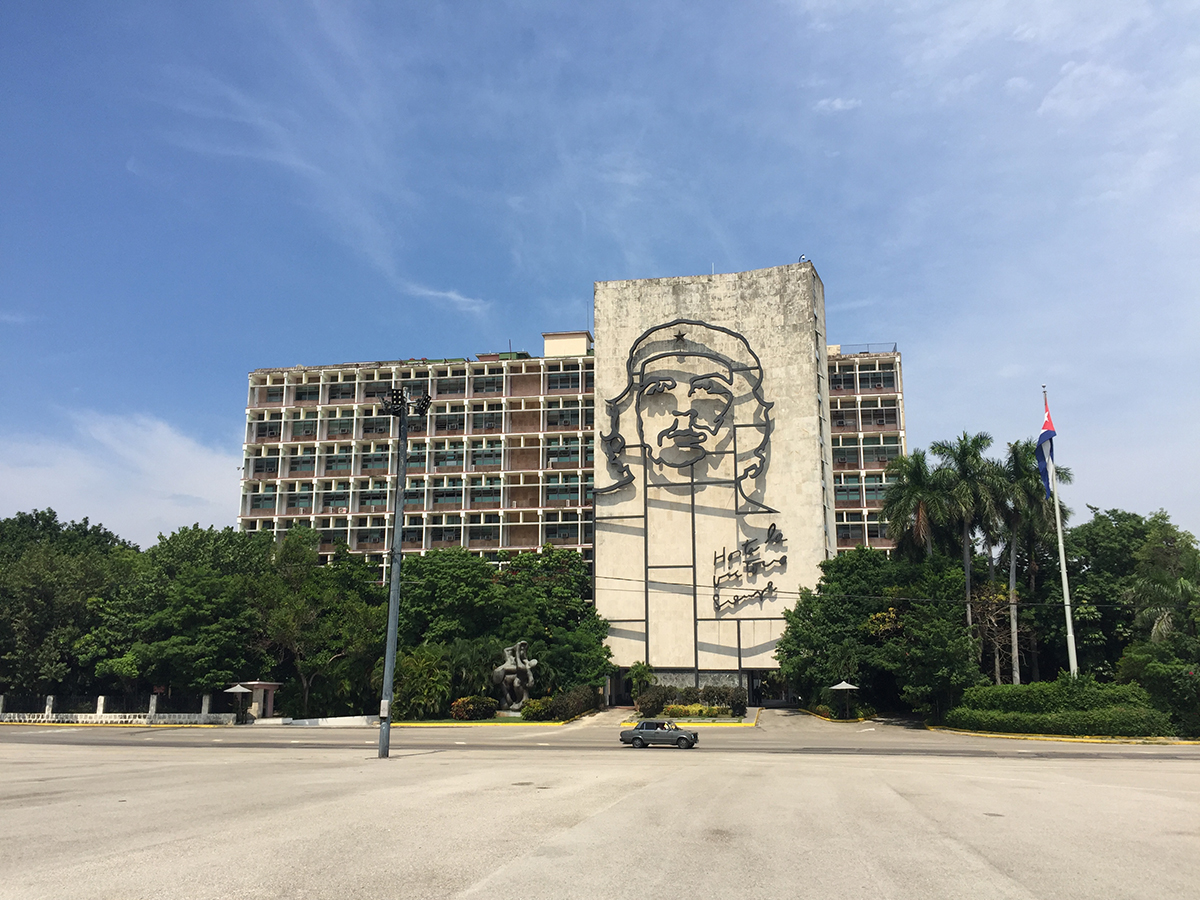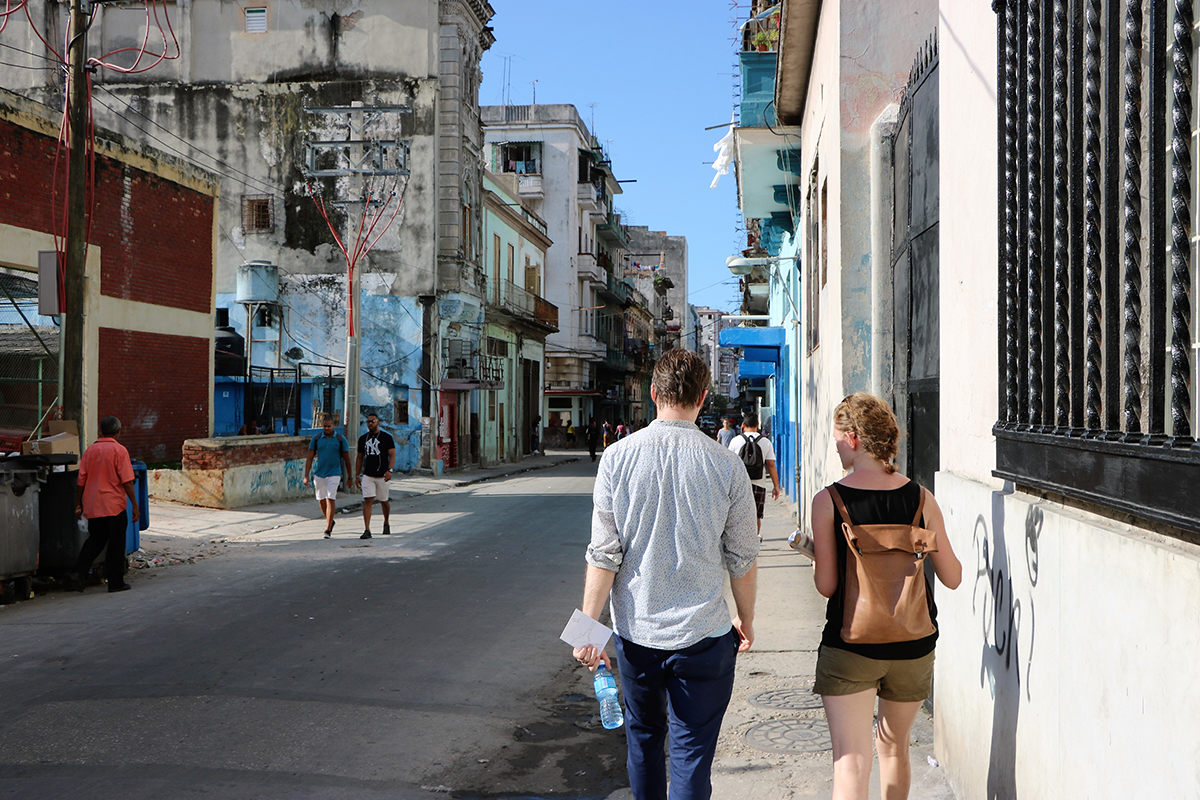Layered paint and propaganda: Mellon seminar visits Cuba
By Edith Fikes

Students participating in the sixth Mellon Collaborative Studies seminar in Architecture, Urbanism and the Humanities spent eight days in Cuba this semester. The trip in September was a component of the interdisciplinary expanded practice seminar, Cuba as Project: Urban, Political, and Environmental Transformations of the Island.
The seminar is taught by visiting assistant professor of architecture Tao DuFour and assistant professor of comparative literature Tom McEnaney, who brought their own areas of interest to the course’s larger theme of transformation. They have encouraged students to do the same, so that they might find unique places where their respective inquiries overlap.
“While the previous Mellon seminar I taught, on urbanization in the Amazon, explored certain theoretical paradigms in anthropology that problematized conceptions of the ‘natural world,’ my desire for the current seminar on Cuba was to approach the topic of the city more directly,” DuFour said.
“The historical depth of Havana is palpable once you are there,” he said, adding that it could be investigated as a “dimension of the ‘natural world.’”
In line with the Mellon seminars’ goal of open exchange between the arts, humanities, social sciences and the design fields, the trip’s itinerary was designed to accommodate the students’ different academic interests and to blur disciplinary boundaries.
The course is clustered into several topics, within which the students pursue critical questions across diverse disciplines – including architecture, urbanism, literature, film and media studies, anthropology, environmental philosophy, political economy and political philosophy.
Students in the Mellon seminar and in DuFour’s architecture studio course, Havana After Nature, were joined by three invited guests: documentary filmmaker Kannan Arunasalam; architectural historian and theorist Iulia Statica; and Sonja Gandert, assistant curator at Cornell’s Herbert F. Johnson Museum of Art.
“I had the privilege of following Arunasalam into a house in the Old Havana neighborhood to interview one of the many families living there," said Patrick Braga ’17, a fifth-year undergraduate majoring in music, economics and urban and regional studies.
“Like many such houses across the old city, the walls presented a palimpsest of layered paint, building materials, and revolutionary propaganda. Having the opportunity to speak to people about their experiences with internal migration in Cuba, and about their relationships with their home, was a fantastic experience that tied solidly into topics we covered in class.”
The group pursued an itinerary that intentionally shifted each day’s focus. The topics – including problems related to housing in the old city; reimagined architectural projects of state institutions; and the direction of development for residential areas, industrial zones and ecological conditions along the Almendares River – were all made more tangible as a result of site visits, each entirely unique to the island.
“My approach to planning has always been policy-focused, and explicitly thinking about architecture and form has typically been secondary,” said Hannah Bahnmiller, M.R.P. ’17. “Our trip to Cuba highlighted how impossible it is to separate the impact of social, political and economic forces from their built form, and just as much, the impact [that] form has on its surrounding milieu.”

For example, she said, “Las Escuelas Nacionales de Arte, now called El Instituto Superior de Arte, made an enormous impression. This place embodied many of the revolutionary desires of the socialist state, but also underscored the weight of idealism and bureaucracy in whatever form they so often arrive.”
McEnaney echoed that sentiment.
“It was an extraordinary trip to study Cuba’s past intersecting with its present,” he said. “From the spectacular ruins of the Instituto Superior de Arte to the socialist housing projects of Alamar, to the eco-community of Las Terrazas and the studio compound of well-known Cuban artist Kcho, the students had an unparalleled opportunity to experience the breadth and depth of Cuban art and architecture in such a short time.”
The Mellon Collaborative Studies in Architecture, Urbanism and the Humanities originated in 2013 as a six-semester partnership between the Andrew D. Mellon Foundation; the College of Architecture, Art, and Planning; Cornell University Library; the Herbert F. Johnson Museum of Art and the Society for the Humanities.
The dual-seminar series has featured expanded practice seminars and urban representation labs that together aim to establish reliable guideposts for advanced study of the global city.
Edith Fikes is a writer for the College of Architecture, Art and Planning.
Media Contact
Get Cornell news delivered right to your inbox.
Subscribe